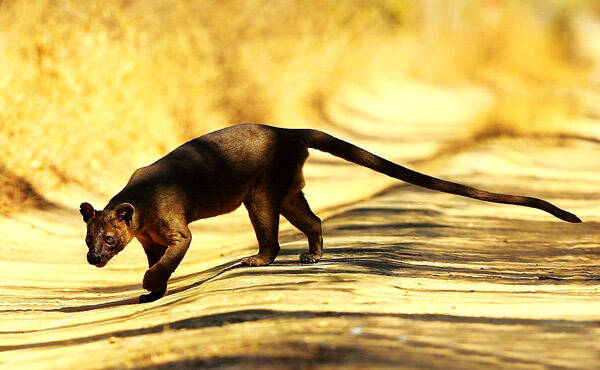Cryptoprocta ferox
IUCN
LCBasic Information
Scientific classification
- name:Cryptoprocta ferox
- Scientific Name:Cryptoprocta ferox,Fossa, Hidden Anal Civet, Hidden Spirit Cat
- Outline:Carnivora
- Family:Schizopoda Viverridae Cryptoaninae
Vital signs
- length:65-80cm
- Weight:5-10kg
- lifetime:Up to 20 years
Feature
It looks like a puma, has a dog-like mouth, short fur, and is brown and shiny all over.
Distribution and Habitat
It is only distributed in the tropical rain forests of Madagascar, Africa.
It inhabits all forest areas on the island of Madagascar. From coastal lowlands to mountainous areas, up to 2,000 meters above sea level.
Appearance
The Falkland mongoose looks like a miniature cougar, very similar to a cat, but with a dog-like mouth, whiskers as long as the head, round ears, and a short and sturdy body. Females weigh 5-7 kg and have a head-body length of 65-80 cm; males weigh 6-10 kg and have a head-body length of 75-80 cm; the height at the shoulder is 37 cm; the tail is very long, 70-90 cm long. Males are significantly larger than females. Their hair is relatively short and has a brown-red luster. The sensitive whiskers are the same length as the skull. Its legs are not very long, but they are very strong, and its claws can be bent and retracted, so it runs very fast.
There are anal preputial glands. Males have a long, rod-like penis with barbs on it. The teeth are shorter and fewer in number (32 to 36) than those of other animals.
Details
The mongoose (scientific name: Cryptoprocta ferox) is called Fossa in foreign language, and has no subspecies.

The nests of the mongoose are hidden, and they are mainly active at night or at dusk, although they are occasionally observed during the day. They are solitary by nature, and usually act alone except during the mating season. They are very territorial, and both sexes use scent glands to mark their respective territories. Aggressive behavior is uncommon, except during mating season.
The mongoose is a tree dweller, a skilled tree climber, and a mysterious one. In mountainous areas, small mammals make up the majority of their diet, while in forested areas, lemurs can account for more than 50% of their prey. They are good at catching a variety of small mammals and are the lemur's biggest natural enemy besides humans. Others include birds, reptiles, amphibians, and insects. Despite their relatively heavy weight, they are still able to jump from tree to tree like squirrels.
The mongoose is usually solitary and is active both during the day and at night, with more activity at night. They communicate with each other through special scents during the breeding season. The mongoose mates between September and November, with the male biting the female's neck during mating, which can last up to 2.5 hours. The mongoose has a very unusual mating system, where a female in estrus will occupy a tree and gather several males under it. Over the course of a week, the female will mate with many different males, and mating can sometimes last for more than a few hours. Then, a new female will arrive and replace the original female, and it is her turn to mate with the gathered males. After a 90-day pregnancy, the female gives birth to 2-4 cubs in the den.
Newborns of the mongoose weigh only 100 grams, and they open their eyes at 15 days old. They can run around at 4 months old, but they don't leave their mothers until they are 15-20 months old. The mongoose is sexually mature at 4 years old and can live up to about 20 years. Rabies, brought into the country by domestic dogs and wild cats, has been a constant threat to the animal.
The small carnivore, which lives in the tropical rainforests of Madagascar, was still "vulnerable" in 1996, but has now been upgraded to "endangered". The main reason for its decline is ecological destruction (90% of the forests in the Madagascar Islands have been developed). Due to the break in the food chain, the mongooses can't find food, so they eat chickens, and they are slaughtered as chicken thieves. As a result, its distribution has become severely fragmented. The remaining original forest is only 8% of what it was before humans arrived on the island of Madagascar, and in this small area, there are less than 3,000 mongooses living.
Listed in the 2016 Red List of Endangered Species of the World Conservation Union (IUCN) ver 3.1 - Endangered (EN).
Listed in Appendix I, II and III of the Convention on International Trade in Endangered Species of Wild Fauna and Flora (CITES) 2019 Edition Appendix II.
Protect wild animals and eliminate game.
Maintaining ecological balance is everyone's responsibility!








